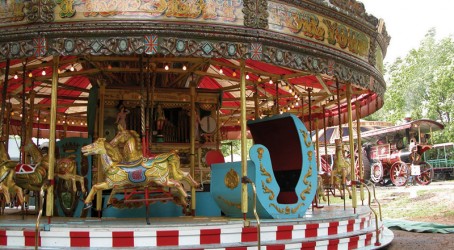Museums
Hollycombe has the largest assembly of working steam power in Britain. Nestled in picturesque Hampshire, the museum takes its name from the Hollycombe estate. A century ago it occupied 4,000 acres with splendid gardens and thousands of trees.
The steam collection was started by John Baldock, who purchased the estate in Liphook in 1951. A fan of steam power, he rescued road steam engines and traditional fairground rides destined for the scrapheap. Baldock’s collection grew over the years and was opened to the public in 1971.
The museum closed its doors briefly in the mid-1980s, owing to a lack of funding. Fortunately an army of dedicated volunteers formed a society to save and reopen the collection. Today the collection is still run by the Hollycombe Steam & Woodland Garden Society.
Hollycombe is slow to get started in the mornings as most of the collection is steam-powered and requires a significant amount of preparation and warm-up time. This child-friendly museum has a steam fairground, barn machinery, traction engines, steam rollers, and dozens of other steam-powered machines dotted around the site. What makes this outdoor museum special is that it has three fully working railways for enthusiasts to enjoy. The first is a 2ft-gauge line which runs for more than a mile through woodland and fields to an old sandstone quarry. It has one diesel and two steam locos.
The standard-gauge railway on the other hand takes visitors on a leisurely ride from the sawmill up the hill to the steam farm. The miniature garden railway ride is a firm favourite with visitors, and takes just five minutes. Its tiny locomotives are more powerful than they appear, hauling children and adults around a loop through most of the collection.
The farm buildings house a range of machinery including a Robinson horizontal steam engine, built in Rochdale more than a century ago. There are also ploughing engines and engines once used for threshing corn or driving grinding mills. Other buildings on the site house more steam-powered machinery, such as a beam engine from 1850 and a sawmill built in 1915. An engine that once powered the paddle steamer Caledonia, a vessel built for service on the Clyde, can also be found at Hollycombe. The engine is a triple expansion diagonal, with a low-pressure cylinder of more than 4ft diameter.
The Edwardian fairground is particularly popular with children. Visitors of all ages can satisfy the thrill-seeker within by taking a spin on old-fashioned rides such as the Golden Gallopers, Chair-o-planes, Steam Swings and Steam Yacht Neptune, the forerunner of the Pirate Ship ride.
Razzle Dazzle, the world’s first white-knuckle ride, dates from 1908. It is normally one of the top attractions at the museum but is currently out of commission for maintenance. It is said to be the earliest ride to use both rotational and tilting motion.
Also among the collection is Mr Field’s steam circus. This enchanting roundabout dates back to the 1870s and is said to be the world’s oldest working mechanically driven ride.
Those who prefer a gentler afternoon at the funfair can hop on the big wheel. The 50ft-tall ride, built in 1914, is driven by a Clayton & Shuttleworth portable steam engine.
Hollycombe’s peaceful woodland gardens are an ideal retreat for visitors looking for rest and relaxation, as well as those keen on exploring the rare plants and trees to be found there.

- Admission is £11.80. Hollycombe is open on bank holidays, most weekends and some weekdays. Railways and attractions are opened periodically. Check the website before making your travel arrangements: www.hollycombe.co.uk.